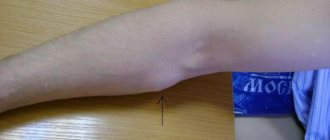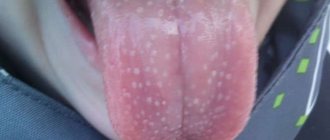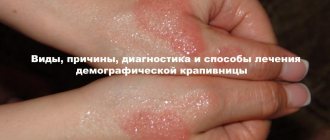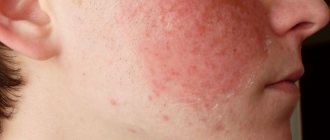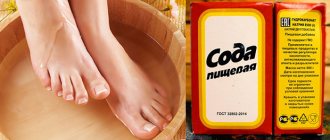A mole on the lip is a benign neoplasm, typical for people with light-colored lips. There are vascular moles, which arise as a result of an increase in the number of capillaries, and pigment moles, which arise as a result of an excess amount of melanin pigment. Most neoplasms do not pose a threat to life or health; it is enough to monitor the condition of the nevus. In difficult cases, a birthmark can turn into melanoma.
Causes of appearance on the lip
Nevi appear on the skin at any time in a person’s life. With equal probability, a neoplasm can occur in a man, woman, or child. The main growth peak occurs in the age range up to 25 years. Suddenly, moles on the upper lip may disappear.
Main reasons, provoking factors:
- Heredity, genetic predisposition - the appearance of nevi is embedded in DNA. The spots appear in the same places as the parents.
- Exposure to ultraviolet rays, prolonged exposure to open sun (the result of an excess of melanin).
- Hormonal imbalances in the body (pregnancy, menopause).
- Internal diseases.
- Stressful situations.
- Injuries (bruises, abrasions), radiation exposure.
Experts in the field of alternative medicine are of the opinion that moles arise due to the release of internal energy.
What does it mean if you have a mole above your lip, on the left or right.
Meaning of a mole above the lip on the right side for women. A mole above the lip on the left and a mole above the lip on the right, the interpretation of these signs on the body is the same. Among famous women and men there are many people with this sign. So, they have a mole above the lip:
Kate Upton, Victoria Bonya, singer Nyusha, Asel Sadvakasova, Asel Kalieva, Cindy Crawford. Natalia Oreiro, Marilyn Monroe.
What does a mole above the lip mean? Basically, such a mole above the lip makes a woman attractive. It’s not for nothing that sometimes we even draw moles for ourselves. Among the court ladies of the 18th and 19th centuries, it was very fashionable and stylish to draw a fly over your lip. The owners of moles above the lip generally have a rather strong character. We can say that they are very similar to men in strength of character. They are often very self-confident, self-sufficient and purposeful. Such women love to climb the career ladder and achieve goals. They make every effort to achieve what they want - to work as a leader. Such women make fairly fair leaders who are very authoritative in the team. The employees love them. In general, the careers of these women generally develop very quickly. Often such women open their own business, and it is quite successful. But, at the same time, if such a woman gets married and falls in love, she generally will not cheat on her partner. This is not in her rules. The owner of a mole above the lip will also never do anything just like that, without carefully weighing it and without thinking it over. These women are quite strict with their children, but they love their child very much. The only thing she can’t like me is that her adult child doesn’t want to achieve anything in life himself. And he tries to sit on his mother’s neck. She definitely won't tolerate this.
Mole above the lip in men.
As for men with a mole above the lip or under the nose, these are mostly Don Juans, Casanovas. Very loving people who lead a dissolute lifestyle. They collect women, but they know how to charm and seduce. At the same time, these guys have great ambitions. He has a clear idea of what he wants. However, often his demands are simply too high. In fact, not everything is so rosy. Women need to be careful with guys like this. Basically, they promise a lot of things to achieve their goals, but then they either disappear or complain about what didn’t work out. You should not hope for a long alliance with them. It is better to consider such a man as a person with whom you can have a good and fun time. Do not be under any illusions, these men are not suitable for marriage. However, the taste and color... Therefore, for some women, such men may well be suitable for a serious relationship.
Localization Features
The nevus can be localized on the upper, lower side of the lips, above the lips, on the corner, border of the lips, in the mouth (gum line, palate). There are signs according to which the location of a mole speaks about a person’s character and future. For predictions, the color of the birthmark, the angle of elevation above the surface of the skin, and location are important. From a medical point of view, the greater the number of spots, the higher the risk of developing melanoma.
A mole on the edge of the lip is unsafe due to contact of the surface of the mouth with saliva and food of different temperatures. An additional risk factor is smoking.
Depending on the type of localization, types of moles are distinguished
| Type of nevus | Localization, description |
| Pigmentary | Common type. Localization area: oral mucosa, inner surface of the cheeks. |
| Border | A nevus in the form of a nodule is localized randomly on the lips (in the middle, above, below the lip). |
| Blue | Around the lips. |
| Dysplastic | The neoplasm is pinkish in color. It represents a lump that rises above the surface of the skin. |
| Hemangioma | Outwardly it resembles a wart. The seal is pierced by capillaries, the temperature effect leads to a change in the color of the inflammation. |
The essence of the phenomenon
A mole (nevus) or birthmark is a congenital or acquired formation on the surface of the skin with bright pigmentation. At its core, such a formation is a local accumulation of the melanin pigment, which provides a bright color. A mole can have a different shade: brown, red, purple, black. With normal development, it is characterized by clear boundaries, regular shapes and uniform coloring.
A mole above the lip can appear in any person, regardless of age. Immediately after birth, the child exhibits hereditary markings. It is genetic predisposition that is responsible for the active growth of nevi in the first year of a baby’s life. The second stage of activation of the birth of moles occurs during puberty of a teenager as a result of hormonal changes in the body. Hormonal imbalances can cause moles to appear at other ages. Other causes of nevi include the following factors:
- the influence of intense solar radiation and infrared rays;
- nervous stress and stress;
- pathologies of internal organs that cause hormonal imbalance and metabolic disorders;
- chronic injuries of the supralabial area.
How to distinguish it from other formations on the lip
Nevi are distinguished from neoplasms with symptoms: seborrheic keratosis, lentigo, basal cell carcinoma. For diagnosis, a biopsy, ultrasound of the lymph nodes in the neck, and an X-ray examination of the jaw are performed. There is a danger that a mole may degenerate into melanoma.
An international ABCDE technique has been developed to distinguish nevus from malignant neoplasms.
| Distinctive feature | Nevus is normal | Melanoma |
| A (asymmetry) – symmetry | Symmetry | Asymmetrical, torn edges |
| B (border irregularity) – indicator of edge uniformity | Smooth borders | Torn borders |
| C (color) – color | Uniform brown color | Brown mixed with red, yellow, transparent or other colors |
| D (diameter) – diameter | ≤ 6 mm | ≥ 6 mm |
| E (evolving) – variability | Appearance, size, diameter do not change | Change at least one indicator |
Should a mole be removed?
Monitoring of the condition of the nevus is necessary. If you have suspicious symptoms, contact an oncologist or dermatologist.
If the neoplasm does not cause concern to the patient or cause psychological discomfort, it is not recommended to remove the nevus. At the same time, the face is the most unprotected part of the body. Under the influence of ultraviolet rays and temperature changes, a mole may change and increase in size.
It is not recommended to remove a birthmark at home using traditional methods. The process is dangerous due to blood poisoning and the addition of a secondary infection.
Birthmark removal methods
| Name of the technique | Description |
| Laser removal | Exposure of the affected area to a laser beam. Healthy cells are not damaged. |
| Cryotherapy | Freezing with liquid nitrogen. Healthy cells may be damaged. |
| Electrocoagulation | Exposure to high frequency current. Scarring may occur after treatment. |
| Operative surgery method | Treatment in a hospital inpatient unit. The method is undesirable due to the likelihood of scar formation. |
| Electrowave method | Removal of a nevus using a radio knife without incisions. The advantage of the method is the effect on the problem area of the skin, the absence of scars. |
The above methods are practically painless. Removal does not guarantee that the tumor will not appear again.
It is recommended to remove new growths during the off-season, when solar activity is minimal. Removal is contraindicated in the following conditions:
- pregnancy, breastfeeding;
- allergic reaction to local anesthesia;
- infectious diseases;
- increased body temperature of unknown cause;
- children's age (up to 14 years).
Methods of disposal
For certain reasons, patients think about removing a mole.
Under no circumstances should they remove it on their own or in beauty salons with a dubious reputation.
If you don’t listen to the advice above, don’t get upset when you discover a rough scar after the procedure or encounter complications.
Only a doctor will remove a mole on the face painlessly and without consequences.
Each of the methods developed for mole removal has advantages and disadvantages. Before the appointment, the doctor will require the patient to undergo all tests and examinations.
Based on the information received, he will select a safe method, the use of which will reduce the likelihood of scar formation. Not a single woman, and not a single man, would agree to a scar in the open facial area. It alienates interlocutors and causes disgust.
Any method of removing moles has its contraindications. You cannot perform a mini-surgery during pregnancy, due to an allergy to an anesthetic drug, during a fever, cold, or an attack of hypertension.
Patients who are concerned about mole removal are advised to make an appointment for surgery in the fall or winter. Exposure to UV rays is minimal. A patient under 18 years of age does not undergo surgery if the nevus does not bother him.
Cryodestruction
The most popular procedure for removing moles on the face is cryodestruction. By choosing it, the doctor acts on the disturbing neoplasm with liquid nitrogen. Acting with cold (-196⁰С), it freezes and destroys it without problems.
Cryodestruction is a popular procedure not only for removing moles. It has found wide application in gynecology, urology, otolaryngology and pediatrics. It is recommended to remove moles with liquid nitrogen in the following cases:
- changes in size, texture and color;
- pain when touched;
- bleeding;
- development of precancerous tumors.
Cryodestruction helps if the nevus is shallow, i.e. in the upper layer of the epidermis.
Laser removal
Using the laser method, damaged skin of benign tumors is removed layer by layer. Within two weeks after the mini-operation, the small depression that has arisen heals. The patient does not scream in pain, but patients with sensitive skin are given anesthesia.
Radio wave removal
Russians are wary of radio wave removal or vaporization. This method is progressive and unique: when making an incision, they do not come into contact with the skin. The neoplasm is exposed to high frequency radio waves.
The dissection effect produces heat released when tissue resists wave penetration. The tip of the electrode releases intracellular molecular energy. It does not interact with cells and does not overheat.
After removal, material remains, which is sent for histological examination. Bleeding and infection are excluded.
Medication
Medications do not help in removing moles on the lip. If they are used, then in addition to other methods. The patient drinks drugs to increase immunity, restore strength, eliminate complications and prevent the reappearance of tumors.
Sometimes antiviral medications are prescribed to protect the body from viruses that are absorbed into the blood and cause irreparable harm to internal systems.
Folk remedies
Moles on the face rarely develop into melanoma. Do not touch them, but if they interfere, it makes sense to try traditional medicine. Before use, visit a dermatologist or oncologist to exclude the development of malignant neoplasms on the skin.
Otherwise, they will aggravate the course of the disease, threatening the patient’s life.
Celandine juice. It cauterizes and disinfects.
It only helps in “deactivating” certain types of nevi. It is applied in a thin layer to the affected area two to three times a day.It wears off and evaporates from the skin quickly due to the lack of viscosity. To prevent such a case, mix with Vaseline.
Vinegar. They get rid of the tumor within a week using vinegar essence.
It is prepared by mixing 70-80% acetic acid with water. When cauterized, the patient experiences pain. The optimal frequency of the procedure is 1 time per day.The cauterization site is bandaged to prevent infection. Skin defects often remain.
Hemp oil. It is used to evaporate fabrics.
The formation is lubricated 3-4 times a day for several weeks. Since the tissue is not directly destroyed, the patient does not experience pain.The mole does not disappear completely: 3-5% of it remains on the skin.
- Lemon juice. It acts similarly to vinegar essence, but does not achieve the same effect. If the nevus disappears, then only after 2-3 weeks of regular use.
Do not rely on the effectiveness of traditional methods. They help in 10-15% of cases. The acid burns the mole, injures the tissue and infects the wound. Doctors insist on a mini-operation, not believing in the effectiveness of traditional medicine. Do not cut off the tumor with sharp objects to prevent serious complications.
Precautions for inflammation
The inflammatory process occurs in 2 cases: when a birthmark is injured or degenerates into a malignant neoplasm.
When a mole is localized in the corner of the lips, accidental biting or scratching is likely. In case of injury, the patient's actions are the same as for any open wound. It is necessary to treat the skin with an antiseptic (furacilin, hydrogen peroxide) at home and monitor the condition of the damaged area. If you have any doubts about further treatment, consult your doctor.
The development of a malignant tumor from a benign one is a dangerous complication. In this case, you must immediately consult a doctor.
What symptoms should you see a doctor for?
It is not necessary to visit a doctor if the mole does not cause inconvenience, does not change color or size. Transformation of a neoplasm into a malignant one is rare. The reason to see a doctor is the presence of one of the listed signs.
- Increase in size.
- A mole on the lower lip causes discomfort.
- Discharge of blood (ichor), presence of erosions.
- Change in color (black, red), increase in pigmentation.
- Itching, painful sensations.
- Lip injuries.
- Change in skin color around the birthmark.
- Formation of dry crusts.
- The compaction changed its density: it became soft, hard.
- Formation of bubbles on the surface of the neoplasm.
- The diameter of the mole is more than 1 cm.
- The nevus appeared in adulthood.
- Increased body temperature.
To prevent inflammation and modification of tumors, it is necessary to adhere to certain rules. If you need to stay outside during periods of solar activity, you should use sunscreen. Avoid scratching, damaging, or traumatizing birthmarks. Particular attention should be paid to prevention for people who have relatives with any type of cancer.
Hidden danger
Most often, a mole on the lip does not cause any inconvenience. Usually the desire to get rid of it arises only because of aesthetic ideas. But it is worth remembering the threat that may lurk behind even the most insignificant neoplasm, which can degenerate into a cancerous tumor. There is a list of factors that play an important role in the pathogenesis of skin cancer.
Firstly, do not forget that the skin on the face is the most unprotected; it is often exposed to ultraviolet radiation. Due to sun exposure, a mole on the lip can change in size and shape, which is one of the first signs of cancer development.
For this reason, it is necessary to pay attention to visual changes and try to protect from sun exposure.
Also, if a mole rises above the surface of the skin, it is more likely to be injured, which absolutely should not be allowed.
If any of the following symptoms appear, you should immediately consult a specialist:
- Injury to a mole.
- The appearance of blood or ichor.
- Itching, pain in this particular area of the skin.
- Inflammatory process in a mole.
- Quick change in size.
- Color change.





